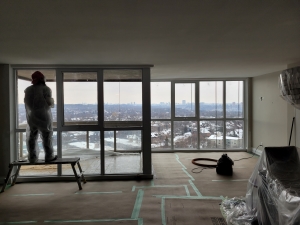Originating from the Latin word ‘fenestra’ meaning “window, opening of light,” fenestration refers to the arrangement of doors and windows in a building. Modern day mid- and high-rise buildings maximize light through great expanses of windows. Replacement of fenestration is a major undertaking requiring detailed analysis, careful planning, and large amounts of coordination, especially at occupied condominiums.
The project can be daunting, even for experienced board members and managers. There are many intricacies to untangle: throughout a building’s lifespan, window upgrades are essential to ensure energy efficiency and maintain envelope performance but how can resident disruption be minimized? And the more pressing question, how can we afford it?
“A fenestration replacement project will be one of the largest—if not the largest—capital expenditure a mid-to-high rise development will ever incur.” – Jon Dickson, M.Eng, P.Eng, BSS, Project Principal.
Fenestration replacement is challenging, expensive, and intrusive. Pretium estimates that from inception to completion, a full replacement project can take up to 50% of a property manager’s time. For a board of Directors, it can cause anxiety and stress due to the financial implications, constant coordination, and intrusive nature of the work, not to mention the varying expectations of the members of a condominium.
Planning for a window project should start several years before the planned replacement. Increases in complaints related to windows and doors can indicate a need for replacement in the near term but planning for such a large expenditure requires a long term horizon. A reputable engineering consultant, such as Pretium Engineering, can provide an honest opinion on the current condition of fenestration assets and realistic replacement budgets, allowing corporations to proactively plan with confidence. It is never too early to undertake an assessment to confirm reserve funds are being collected towards a realistic replacement budget.
 If a window replacement is required earlier than anticipated in the Reserve Fund Study, or if undervalued, it may not be adequately funded. Financial planning is a critical component to a successful replacement program and needs to be accounted for appropriately. Should the program be under funded, it will be up to the Board, through consultation and discussion, to determine how much additional funds are required and how they will be raised.
If a window replacement is required earlier than anticipated in the Reserve Fund Study, or if undervalued, it may not be adequately funded. Financial planning is a critical component to a successful replacement program and needs to be accounted for appropriately. Should the program be under funded, it will be up to the Board, through consultation and discussion, to determine how much additional funds are required and how they will be raised.
If not managed correctly, owner expectations can complicate an already complicated project. Communicating installation and schedule challenges to the owners early and often throughout the process is essential to the perceived success of the project. The invasive nature of the work and temporary displacement of the occupants’ belongings and the occupants themselves can generate tension and stress. Scheduling is typically done through property management; effective communication and prioritizing units with active issues helps maintain the corporation’s assets and reduces liability while reducing perceived concerns from the owners.
Property Management requires the services of a trusted consultant, such as Pretium Engineering, to oversee the construction work in progress, provide the necessary contract administration, support the property management/board with dissemination of information to the building occupants, and resolve technical issues on site. Below are four points to consider when planning for a fenestration replacement process:
1. Window/Door Replacement Projects Can be Costly
There is no one size fits all solution. The cost of a project is dependent on building location, ease of access, interior finishes, and type of window system installed.
With a window replacement potentially costing millions of dollars (and often tens of millions of dollars), a board will be eager to reduce additional costs. A contingency allowance is established to account for unforeseen issues which may arise during the project. It is not uncommon once old windows are removed to discover previous anchorage and control layer tie-ins not conforming to modern standards. Prudent project planning will include the removal and mock-up installation of several ‘test’ windows. While mock-up installations help immensely, they typically do not account for every situation encountered in the entire building. Addressing concealed conditions such as poor underlying infrastructure can increase costs significantly. It’s important to have contingency allowances for concealed conditions and other identified variables. Unforeseen issues will arise, and a variation in fixed fees ought to be anticipated although these can be greatly reduced through use of a mock-up prior to the fully tendered program.
 Pretium Engineering recommends a CCDC2 stipulated price contract, which generally protects against increases in cost due to manufacturing inflation along with an appropriate contingency allowance to address unforeseen site conditions upon removal of the original windows.
Pretium Engineering recommends a CCDC2 stipulated price contract, which generally protects against increases in cost due to manufacturing inflation along with an appropriate contingency allowance to address unforeseen site conditions upon removal of the original windows.
2. Things Might Not Line Up: Aesthetic Reality – Managing Owner Expectations
In brand new buildings, the window wall is installed before finishing components such as railings giving installers full access to produce a consistent installation. In a restoration project, the windows are replaced with all other elements already installed and the new windows and doors must fit around existing elements. This means things may not line up.
If not specified in the contract, the benchmark for acceptable deviations should be industry standard practice for restoration projects, rather than strict deviation limits often stipulated within specifications for new construction. Many restoration contractors working in the mid-high rise window replacement sector are able to achieve end products with minimal deviation visible to the naked eye from ground level even though the installations exceed allowable deviations common in the new construction sector.
Managing owner expectations regarding the finished work’s visual aesthetics before the project begins can reduce the likelihood of disputes following project completion.
3. Active Scheduling & Communication
Pretium Engineering generally recommends beginning phased work in the most problematic location where practical and economical. For example, if all else is equal, if the north elevation of a building has the majority of the reported leaks or condensation concerns, work should begin there first.
While there are many ways to arrange the replacement program, Pretium Engineering designs their replacement programs around minimizing resident disruption. To achieve that end, all windows/doors within a Suite should be replaced concurrently such that a resident is disrupted only once. Under this scenario, Owners should expect upwards of 10 days for full completion of a suite although active replacement is only required during the first few days with the remainder being completion of interior finishes. The schedule WILL fluctuate depending on weather and complications arising; a successful project is not one which eliminates delays. That is not practical. A successful project is one which communicates the unavoidable delays effectively.
4. Commitment on Management Side
Since it is not possible to predict specific dates of replacement more than a week in advance (due to weather related delays), a property manager will need to distribute multiple notices, take many calls, and write lots of emails during a project’s duration.
Coordinating suite entry requires good record keeping and administration. Relaying resident concerns and recording deficiencies will be part of the follow-up to the job, in fact—it can take up as much time as the initial planning.
Often, the amount of time needed to properly meet the demands of a fenestration project is not properly realized. In some (most) cases, additional staff may be needed to allow the property manager to manage this project along with all of the other building management duties. Due to time sensitivity, decisions affecting the project must be made promptly and on-the-fly—waiting for the next board meeting may not be feasible—meaning board members should also expect heightened levels of involvement during a fenestration replacement project.
Jon Dickson, M.Eng, P.Eng, BSS, is a Project Principal for Pretium Engineering.
Pretium Engineering has offices in Toronto, Newmarket, Burlington, Kitchener/Waterloo, with satellite offices in Windsor and Ottawa. Connect at www.pretiumengineering.com








